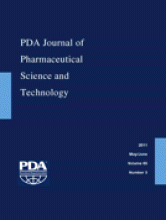Abstract
This review article discusses several technologies using the power of genetic analysis that were used to rapidly detect microbial contamination, provide a more accurate identification of microorganisms, understand the microbial diversity in cleanroom environments, and optimize pharmaceutical processes. Nucleic acids were extracted and purified from enrichment cultures of product suspensions, growing cultures, microbial isolates, and directly from water and cleanroom surfaces. The extracted microbial DNA was either amplified using different polymerase chain reaction (PCR) assays or analyzed using DNA microarray technology. PCR assays were targeting genes coding for structural proteins, ribosomal subunits, or catabolic enzymes. Different PCR formats were tested ranging from single gene amplification to multiplexing. The detection of the amplified fragments was performed by qualitative or quantitative analysis. In some studies the amplified products were cloned/sequenced or sequenced to accurately determine the identity and diversity of the microbes present in the samples. DNA microarray analyses provided a higher multiplexing capability than PCR assays, as more than 3000 genes were analyzed in a single reaction, providing a higher resolution and specificity of the microorganisms present in cleanroom environments and pharmaceutical samples.
LAY ABSTRACT: Molecular technologies using genetic sequences were used to rapidly detect microbial contamination, provide a more accurate identification of microorganisms, understand the types of microbes in pharmaceutical laboratories, and make pharmaceutical processes more efficient. The microbial genetic sequences were extracted from different types of samples. Then the extracted sequences were analyzed by looking for specific signatures to determine the identity and function of the different microbes in products, environments, and processes. Genetic analyses provided a better description of the different types of microbes present in pharmaceutical samples with a rapid quality evaluation of products and processes.
- © PDA, Inc. 2011
PDA members receive access to all articles published in the current year and previous volume year. Institutional subscribers received access to all content. Log in below to receive access to this article if you are either of these.
If you are neither or you are a PDA member trying to access an article outside of your membership license, then you must purchase access to this article (below). If you do not have a username or password for JPST, you will be required to create an account prior to purchasing.
Full issue PDFs are for PDA members only.
Note to pda.org users
The PDA and PDA bookstore websites (www.pda.org and www.pda.org/bookstore) are separate websites from the PDA JPST website. When you first join PDA, your initial UserID and Password are sent to HighWirePress to create your PDA JPST account. Subsequent UserrID and Password changes required at the PDA websites will not pass on to PDA JPST and vice versa. If you forget your PDA JPST UserID and/or Password, you can request help to retrieve UserID and reset Password below.






